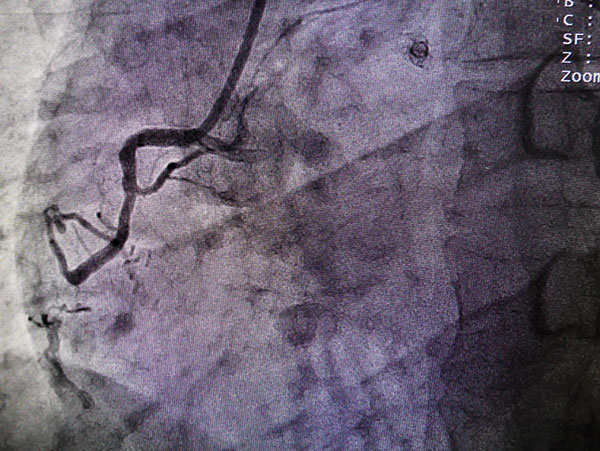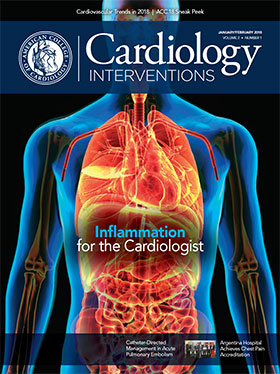Journal Wrap | The Hottest Research from Various Peer-Reviewed Journals
Link Between MR and Mortality, Rehab in TAVR Patients Examined in NCDR Study

Moderate or severe mitral regurgitation (MR) may be associated with increased mortality or heart failure (HF) rehospitalization in patients who undergo transcatheter aortic valve replacement (TAVR), according to a study published in the Annals of Thoracic Surgery.
Using data from the STS/ACC TVT Registry, Kreton Mavromatis, MD, FACC, et al., reviewed 11,104 records of patients who underwent a TAVR procedure for aortic stenosis (AS) between Jan. 3, 2012 and Dec. 31, 2013. The researchers excluded patients who had prior mitral valve replacement, as well as those without baseline MR data. After dividing MR severity into four groups (none, mild, moderate and severe), the researchers conducted statistical modeling to determine mortality and mortality or HF at 30 days and one year after TAVR. Read More >>>
Results showed that at baseline, 36.8 percent of patients had moderate or severe MR. After adjusting for independent predictors of mortality, higher MR severity was associated with 30-day mortality or HF rehospitalization. Similarly, there was a link between higher MR severity and mortality or HF rehospitalization.
"The study establishes the association of moderate and severe MR with TAVR clinical outcomes in AS patients and demonstrates that MR improves after TAVR for many patients."
After undergoing TAVR, MR severity improved by at least one grade for 79 percent of patients with severe MR and 66 percent with moderate MR. Furthermore, patients with improved MR had lower risk of mortality or HF rehospitalization compared with those whose MR severity was unchanged or worse. The researchers identified several factors linked to persistent MR, including smaller body surface area, pre-TAVR atrial fibrillation/flutter and prior aortic valve procedure.
According to the authors, the study establishes the association of moderate and severe MR with TAVR clinical outcomes in AS patients and demonstrates that MR improves after TAVR for many patients. For the majority of patients whose baseline MR was severe or moderate, MR improved soon after the TAVR procedure, suggesting that a staged approach to treating AS in MR patients may be reasonable, the authors write. In patients who are unlikely to have MR improvement after TAVR, the authors conclude that treatment strategies could include double valve surgery or TAVR with percutaneous mitral valve repair. Further treatment, such as mitral valve repair or replacement, could be considered in patients who undergo TAVR but whose MR does not improve.
Mavromatis K, Thourani VH, Stebbins A, et al. Ann Thorac Surg 2017;104:1977-85.
Sirolimus- vs. Everolimus-Eluting Stent After PCI
The MiStent sirolimus-eluting bioabsorbable polymer stent was noninferior to the everolimus-eluting durable polymer stent at 12 months, according to research published in The Lancet.
Robbert J. de Winter, MD, et al., performed a randomized, single-blind, multicenter study (DESSOLVE III) at 20 hospitals in Europe comparing a sirolimus-eluting bioresorbable polymer stent (MiStent) to an everolimus-eluting durable polymer stent (Xience). The primary endpoint was a noninferiority comparison of a device-oriented composite endpoint – cardiac death, target vessel myocardial infarction or clinically indicated target lesion revascularization at one year. Read More >>>
The researchers assigned 703 patients with 1,037 lesions to MiStent, of whom 697 received the index procedure, and 695 patients with 993 lesions were assigned to Xience, of whom 690 received the index procedure. Overall, lesion characteristics were comparable except for long lesions (>18 mm) being more frequent in the sirolimus-eluting stent group than in the everolimus-eluting stent group. Mean stent length and diameter per stent was slightly shorter and larger in the sirolimus-eluting stent group, but these variables per lesion, and the number of stents used, did not differ between groups.
The primary device-oriented composite endpoint occurred in 40 patients (5.8 percent) in the sirolimus-eluting stent group and in 45 patients (6.5 percent) in the everolimus-eluting stent group. Noninferiority of the sirolimus-eluting stent compared with the everolimus-eluting stent was shown, with an absolute difference of –0.8 percent.
"There were no between-group differences for the patient-oriented composite endpoint, and the per-protocol analysis of the primary endpoint also showed no difference between groups."
Frequency of cardiac death, target vessel myocardial infarction and clinically indicated target lesion revascularization was similar for both stent types. There were no between-group differences for the patient-oriented composite endpoint, and the per-protocol analysis of the primary endpoint also showed no difference between groups. At 12 months, definite and probable stent thrombosis did not differ between groups.
The authors write the trial was limited to a short follow-up of 12 months, which is three months after the end of drug elution. Longer duration of low level drug might be associated with a rebound of neointimal hyperplasia once the upregulation of p27 was eliminated. The protocol therefore specified patient follow-up will continue for up to three years.
de Winter RJ, Katagiri Y, Asano T, et al. Lancet 2017;Dec 1:[Epub ahead of print].
Do Second Arterial Conduits for CABG Lead to Better Outcomes?

Although only a small proportion of CABG patients received a second arterial conduit, use of a second arterial conduit was associated with lower mortality and less major adverse cardiovascular and cerebrovascular events (MACCE), according to a study published in Circulation. Importantly, the radial artery appeared to be equivalent to the right internal mammary artery from the perspective of mortality and superior from the perspective of MACCE and sternal wound infections.
Andrew B. Goldstone, MD, et al., analyzed a statewide clinical registry of coronary artery bypass grafting (CABG) in 126 hospitals. Outcomes of interest were all-cause mortality and a composite of MACCE including stroke, myocardial infarction and repeat revascularization. Sternal wound infections were also evaluated. Propensity score techniques were used to match cohorts who underwent CABG using the left internal mammary artery and a second arterial conduit (right internal mammary artery or radial artery) compared with venous conduits. Only patients who underwent primary, isolated multivessel CABG were included. An instrumental variable approach was used as a sensitivity analysis. A subgroup analysis comparing right internal mammary artery versus radial artery was also performed. Read More >>>
CABG with a second arterial conduit was performed in 5,866 patients, compared with 53,566 who underwent CABG with left internal mammary artery and venous conduits. After matching, there were 5,813 pairs. Median follow-up was 5.3 years. Thirty-day mortality was not different between groups (0.81 vs. 0.86 percent). However, seven-year mortality was significantly lower when a second arterial conduit was used (10.6 vs. 13.1 percent; hazard ratio [HR], 0.79; p < 0.0001).
"These findings suggest surgeons should consider lowering their threshold for using arterial grafts and that the radial artery may be the preferred second conduit. "
MACCE was significantly lower when a second arterial conduit was used (31.0 vs. 36.2 percent; HR, 0.80; p < 0.0001). No differences were seen in rates of sternal wound infections at one year (1.38 percent with second arterial conduit vs. 1.44 percent). There was no difference in mortality between right internal mammary artery and radial artery grafting. However, after comprehensive adjustment, including surgeon-specific effects, right internal mammary artery grafting was associated with increased MACCE (HR, 1.12). Right internal mammary artery grafting was also associated with increased rates of sternal wound infections (2.29 vs. 1.22 percent). The authors conclude these findings suggest surgeons should consider lowering their threshold for using arterial grafts and that the radial artery may be the preferred second conduit.
Goldstone AB, Chiu P, Baiocchi M, et al. Circulation 2017;Dec 14:[Epub ahead of print].
Lower Limb Revascularization Associated With Reduced Death and Amputation in England

Patient outcomes after lower limb revascularization have improved over the past decade in England, according to a study published recently in Circulation.
Katriina Heikkila, PhD, et al., examined 103,934 patients who underwent endovascular or surgical lower limb revascularization for infrainguinal peripheral artery disease (PAD) in England between January 2006 and December 2015. Results showed that 77,213 patients underwent endovascular revascularization and 26,721 patients underwent surgical revascularization during the 10-year period. Most patients were men and aged 65 years or above. Read More >>>
The authors found that the estimated one-year risk of major amputation reduced from 5.7 percent to 3.9 percent following endovascular revascularization, and from 11.2 percent to 6.6 percent following surgical revascularization. In addition, the one-year risk of death also reduced, from 9.5 percent to 6.0 percent following endovascular revascularization, and from 11.1 percent to 6.4 percent following surgical revascularization. These findings were observed for all categories of PAD severity, with the largest reductions among patients who had severe limb ischemia with ulceration or gangrene.
Overall, morbidity increased over the study period, and a larger proportion of patients were treated for the severe end of the PAD spectrum using less invasive procedures. The authors conclude that despite higher morbidity, “these trends suggest overall improvements in the outcomes for patients with severe PAD during a period of centralization and specialization of vascular surgical services in the U.K.”
Heikkila K, Mitchell DC, Loftus IM, et al. Circulation 2018;Jan 9:[Epub ahead of print].
Keywords: ACC Publications, Cardiology Interventions, Absorbable Implants, Amputation, Aortic Valve, Aortic Valve Stenosis, Atrial Fibrillation, Body Surface Area, Coronary Artery Bypass, Drug-Eluting Stents, Follow-Up Studies, Gangrene, Heart Failure, Hyperplasia, Lower Extremity, Mammary Arteries, Mitral Valve, Mitral Valve Insufficiency, Myocardial Infarction, Peripheral Arterial Disease, Polymers, Propensity Score, Radial Artery, Registries, Research, Research Personnel, Single-Blind Method, Sirolimus, Stents, Stroke, Surgeons, Thoracic Surgery, Thrombosis, Transcatheter Aortic Valve Replacement, Up-Regulation, Vascular Surgical Procedures, Wound Infection
< Back to Listings

